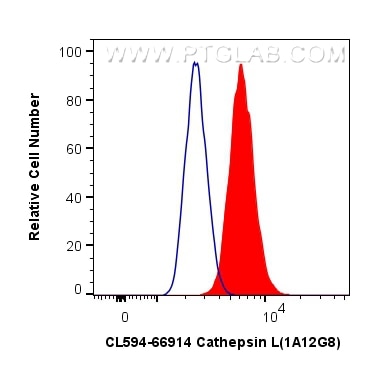Anticorps Monoclonal anti-Cathepsin L
Cathepsin L Monoclonal Antibody for FC (Intra)
Hôte / Isotype
Mouse / IgG2b
Réactivité testée
Humain
Applications
FC (Intra)
Conjugaison
CoraLite®594 Fluorescent Dye
CloneNo.
1A12G8
N° de cat : CL594-66914
Synonymes
Galerie de données de validation
Applications testées
| Résultats positifs en cytométrie | cellules A549 |
Dilution recommandée
| Application | Dilution |
|---|---|
| Flow Cytometry (FC) | FC : 0.80 ug per 10^6 cells in a 100 µl suspension |
| It is recommended that this reagent should be titrated in each testing system to obtain optimal results. | |
| Sample-dependent, check data in validation data gallery | |
Informations sur le produit
CL594-66914 cible Cathepsin L dans les applications de FC (Intra) et montre une réactivité avec des échantillons Humain
| Réactivité | Humain |
| Hôte / Isotype | Mouse / IgG2b |
| Clonalité | Monoclonal |
| Type | Anticorps |
| Immunogène | Cathepsin L Protéine recombinante Ag27951 |
| Nom complet | cathepsin L1 |
| Masse moléculaire calculée | 38 kDa |
| Poids moléculaire observé | 43 kDa |
| Numéro d’acquisition GenBank | BC012612 |
| Symbole du gène | CTSL1 |
| Identification du gène (NCBI) | 1514 |
| Conjugaison | CoraLite®594 Fluorescent Dye |
| Excitation/Emission maxima wavelengths | 588 nm / 604 nm |
| Forme | Liquide |
| Méthode de purification | Purification par protéine A |
| Tampon de stockage | PBS avec glycérol à 50 %, Proclin300 à 0,05 % et BSA à 0,5 %, pH 7,3. |
| Conditions de stockage | Stocker à -20 °C. Éviter toute exposition à la lumière. Stable pendant un an après l'expédition. L'aliquotage n'est pas nécessaire pour le stockage à -20oC Les 20ul contiennent 0,1% de BSA. |
Informations générales
CTSL1(Cathepsin L1) is also named as CTSL and MEP, belongs to the peptidase C1 family. It is a lysosomal proteinase whose expression is also up-regulated in the skeletal muscle during starvation(PMID:20088826). It plays an intracellular role in normal intestinal epithelial polarization and initiation of neoplasia(PMID:17622569). CTSL1 also improves cardiac function and inhibits cardiac hypertrophy, inflammation, and fibrosis through blocking AKT/GSK3B signaling(PMID:19096818). The full length protein is 38 kDa with a signal peptide, two propeptide and a glycosylation site. It has been detected the 36 kDa, 39 kDa, 29 kDa and 21 kDa in rat gastrocnemius muscle. These forms of cathepsin L could either be attributed to differences in glycosylation or to partial processing of the proenzyme. (PMID:11696001)
Protocole
| Product Specific Protocols | |
|---|---|
| FC protocol for CL594 Cathepsin L antibody CL594-66914 | Download protocol |
| Standard Protocols | |
|---|---|
| Click here to view our Standard Protocols |


